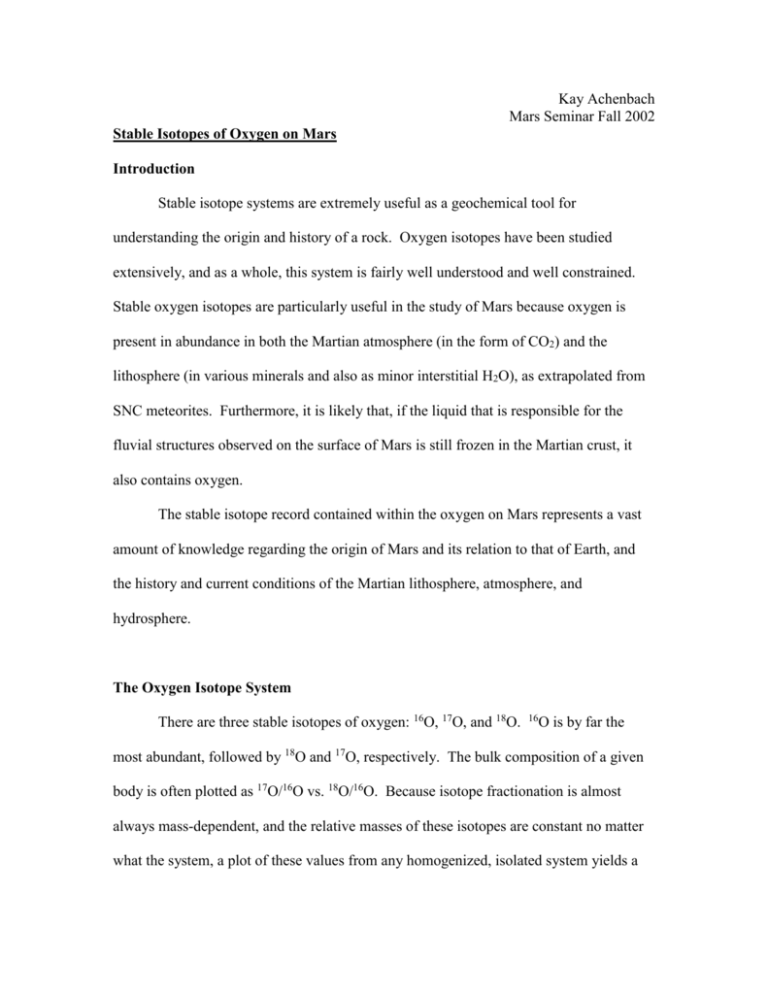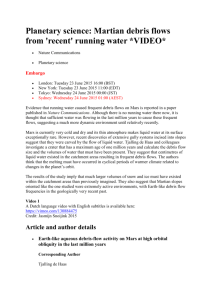Kay Achenbach
advertisement

Kay Achenbach Mars Seminar Fall 2002 Stable Isotopes of Oxygen on Mars Introduction Stable isotope systems are extremely useful as a geochemical tool for understanding the origin and history of a rock. Oxygen isotopes have been studied extensively, and as a whole, this system is fairly well understood and well constrained. Stable oxygen isotopes are particularly useful in the study of Mars because oxygen is present in abundance in both the Martian atmosphere (in the form of CO2) and the lithosphere (in various minerals and also as minor interstitial H2O), as extrapolated from SNC meteorites. Furthermore, it is likely that, if the liquid that is responsible for the fluvial structures observed on the surface of Mars is still frozen in the Martian crust, it also contains oxygen. The stable isotope record contained within the oxygen on Mars represents a vast amount of knowledge regarding the origin of Mars and its relation to that of Earth, and the history and current conditions of the Martian lithosphere, atmosphere, and hydrosphere. The Oxygen Isotope System There are three stable isotopes of oxygen: 16O, 17O, and 18O. 16 O is by far the most abundant, followed by 18O and 17O, respectively. The bulk composition of a given body is often plotted as 17O/16O vs. 18O/16O. Because isotope fractionation is almost always mass-dependent, and the relative masses of these isotopes are constant no matter what the system, a plot of these values from any homogenized, isolated system yields a straight line with a slope of 0.52. (Franchi et al., 1997a) Since the relative abundance of the three isotopes depends on the system being analyzed, different closed systems plot along parallel lines. (Lewis, 1999) Different bodies in the solar system plot along different lines on this three-isotope plot, implying that the solar system was not homogenized with respect to O isotopes. (Lewis, 1999) Materials from the Earth (and the Moon) plot along one line, and many meteorites plot along different lines (Figure 1). These mass-fractionation lines are a good indicator of origin, such that any object that falls along the mass-fractionation line of Earth, for example, most likely formed within the closed system of Earth. The bulk O isotope abundances of the SNC meteorites clearly define their own mass-fractionation line, which has been termed the Mars Silicate Fractionation Line (MSFL). (Figure 2) Figure 1: Mass fractionation lines of achondrites. (From McSween, 1999.) SNC meteorites Because the meteorites plot along a single mass-fractionation line, the SNC meteorites are, without reasonable doubt, from the same parent body. That parent body is most likely Mars, as demonstrated by the relative abundances of gas trapped inside shock-melted glass created in the meteorites by the impact that knocked them off of their parent body. Those gases are identical in composition to the Martian atmosphere. (McKeegan & Leshin, 2001) The difference between the MSFL and the Terrestrial Fractionation Line is very small—less than 0.3‰--but it is reproducible (1s standard deviation of 0.07‰). The MSFL differs from the TFL by a mean 17O value of +0.321+/- 0.013‰. The meteorites are very tightly clustered along the MSFL, indicating that their source is isotopically homogenized. (Figure 2) Therefore, the 17O of Mars is most likely +0.321+/- 0.013‰ as well. (Franchi et al., 1997a) Figure 2: SNC meteorites are tightly clustered along the MFL. (From Eiler et al., 2000.) The ages of the meteorites cover a very broad range of time, and the homogeneity of the meteorites indicates that the Martian lithosphere must have been isotopically homogenized very early on in its history. (McKeegan & Leshin, 2001) Bulk Composition of Mars Some scientists have designed compositional models for Mars by matching the O isotope composition of Mars (as extrapolated from the SNC meteorites) to mixtures of different classes of chondrites. (McSween, 2002) This has met with only marginal success, as many of the models are in strong disagreement with each other. Most attempts at compositional models suggest that Mars is more Fe-rich than the Earth. However, there is very little agreement on the estimates these models provide of the amount of volatiles present in the original makeup of Mars, and the size, density, and sulfur content of the Martian core. (McSween, 2002) Secondary minerals in SNC meteorites The MSFL is derived from the bulk compositions of the SNC meteorites, and, by definition, the bulk compositions lie along it. (McKeegan & Leshin, 2001) However, water obtained from secondary minerals in the meteorites deviate from the MSFL—they lie between the MSFL and the TFL. Therefore, they are clearly out of equilibrium with the silicates in the meteorite, which implies that the Martian hydrosphere and the Martian lithosphere are out of equilibrium. (McKeegan & Leshin, 2001) Some of these secondary minerals are carbonates formed by the evaporations of saline solutions at surface or near-surface conditions. (Eiler et al., 2000) As on Earth, it may be that 18O-depleted meteoric water on Mars influenced the 18O of precipitates formed from that water. (Eiler et al., 2000) This would occur as secondary minerals incorporated fluids from the hydrosphere that were affected by fractionation in the Martian atmosphere, a hypothesis that is supported by data from the H and C isotopic systems. (McKeegan & Leshin, 2001) These secondary carbonates (along with some secondary silicates) have a higher 18O than their host rock, indicating that they formed at low temperatures (McKeegan & Leshin, 2001). Interestingly, there is some variation in O isotopes with mineral composition (specifically, between earlier-forming Ca-rich carbonates and later-forming Mg-rich carbonates). It is possible that a) the temperature varied during the formation of these minerals, or b) the fluid composition varied. (McKeegan & Leshin, 2001) The fluid hypothesis is more likely, as there is no observable alteration of the basalt host rock as one would expect to see if the temperature had been so high as to cause the discrepancy. (Eiler et al., 2000) Interestingly, these secondary minerals are depleted in 18O compared to terrestrial marine carbonates by 15-35‰, while they are enriched compared to terrestrial marine carbonates in isotopes of H, C, and N. O isotope evidence for sedimentary rocks This evidence of interaction implies that there is (or was at some point in the past) a great deal of interaction between the Martian hydrosphere, lithosphere, and atmosphere. Because of this and because of the evidence of fluvial features on the Martian surface, it is thought that the regolith of Mars harbors large amounts of volatiles (most likely water). (Kerridge & Shipley, 1988) In light of that, some researchers have even gone so far as to propose that type I carbonaceous chondrites are really sedimentary rocks from Mars. (Franchi et al., 1997b) Franchi et Al (1997b) has found that the CI chondrites do have 17O displacements relative to the TFL that are similar to the SNCs, as well as similar D, 13C, 15N, and noble gas isotope fractionations. However, while the 17O of the CI chondrites is similar to the SNCs, the 18O is 10-15‰ different, making a Martian origin unlikely (Fig 3). Interestingly, magnetite from the CI chondrites does approach Martian 18O values (although, of course, the bulk rock does not); further study is needed in this area. (Franchi et al., 1997b) Figure 3: CI Chondrites and SNC meteorites do not have the same O isotope signatures. (From Franchi et al, 1997b) Martian atmosphere The precise O isotope composition of Mars’ atmosphere is unknown. Viking measurements indicated that the 18O/16O fractionation of the Martian atmosphere was very similar to Earth’s oceans (~0‰), whereas Earth-based estimates showed a much lighter value of –102 +/ 36 ‰ to –130 +/- 80‰. (Eiler et al., 2000) The only concrete evidence regarding the O isotopes in the Martian atmosphere comes from the O isotopes in the volatiles in the SNC meteorites, which are also substantially lighter than the Earth standard mean ocean water. This is surprising, given that the oxygen escape rate from the Martian atmosphere is ~10-7 atoms/cm2/s, which would presumably cause a depletion of lighter O isotopes. That the atmosphere is still 18O-depleted rather than 16O-depleted implies that the atmosphere may be buffered by a massive reserve of O in the hydrosphere. (Eiler et al., 2000) The Martian atmosphere undergoes pressure changes of ~6-~9 mbar due to the condensation and sublimation of CO2 at latitudes of 50o and above.(Eiler et al., 2000) Just as on earth, condensation and sublimation of the atmosphere cause O fractionation. Eiler et al. (2000) found that, at Martian conditions, phase changes in CO2 cause large O fractionations to develop between the ice phase and the vapor phase, while very little C fractionations are present even over large temperature differences. (Figure 4) Thus, the O fractionation present in the Martian atmosphere is a good indicator of recent condensation/sublimation history. (Eiler et al., 2000) During the time that these pressure changes are occurring (over the span of tens of days), the atmosphere is most likely not well-mixed on a planet-wide scale. (Eiler et al., 2000) This is a result of the fast rate of phase changes and the fact that water, dust, and other trace constituents are not evenly distributed throughout the atmosphere. As a result, it is likely that the equatorial regions of Mars will have a fractionation representing no condensation, while poles will have a fractionation representing a great deal of Figure 4: 18O and d13C fractionation in CO2 at Martian conditions. (From (Eiler et al., 2000).) condensation. Such a disparity between the air masses over the equatorial regions and the poles likely depends on the scale of vapor-ice equilibrium, the extent of mixing between vapor reservoirs with different histories, the mixing of vapor in the atmosphere with vapor sublimating from ice, and non-equilibrium fractionation such as the diffusion of CO2 through air masses rich in non-condensible gases. Thus, the disparity between different parts of the atmosphere could be as great as several tens of per mil, or only several per mil. Current analytical methods do not have the resolution to determine if this type of fractionation exists in the Martian atmosphere—+/-1‰ would be needed. (Eiler et al., 2000) To summarize, the atmosphere is the largest reservoir of labile oxygen on Mars. (Eiler et al., 2000) Fractionation between vapor and ice phases of CO2 may cause some air masses in the atmosphere to be especially light. Exchange between these light isotopes in the atmosphere with liquid volatiles in the hydrosphere may cause light isotope enrichment in minerals that form in equilibrium with liquid, such as secondary minerals in SNC meteorites. (Eiler et al., 2000) Oxygen isotopes in the CO2 in Mars can give indications of the condensation history of high-latitude air masses, develop models of the mixing between the high-latitude and low-latitude portions of the Martian atmosphere, and record climate changes in the records contained in the polar caps. (Eiler et al., 2000) O isotopes as biomarkers On Earth, biogenic phosphate is heavy (with a 18O of ~20-25‰) compared to igneous phosphate in apatite (with a 18O of 5-8‰). The O in phosphates of differing origins can only be exchanged at low temperatures through biological processes. By studying phosphates in meteorites, it is conceivable that it would be possible to determine if any phosphates have been exchanged at low temperatures due to biological processes. This, however, is dependent on determining the 18O of Martian water. (Greenwood & Blake, 2001.) Discussion Oxygen isotopes are a very useful system for obtaining a large amount of information about geological processes. In relation to Mars, oxygen isotopes have already proven to be of inestimable value in that they have shown SNC meteorites come from a common parent body, which have provided us with a bulk silicate fractionation for O isotopes on Mars. This has allowed for hypotheses regarding the bulk composition of Mars and CI chondrites as sedimentary meteorites from Mars, and inferences regarding the interactions between the lithosphere, the hydrosphere, and the atmosphere. Furthermore, O isotopes have the potential to refine our understanding of the Martian atmosphere and give us a way to determine if there has been any biological activity on Mars as well. References: Eiler, John M., Kitchen, Nami, and Rahn, Thom A. (2000) Experimental constraints on the stable-isotope systematics of CO2 ice/vapor systems and relevance to the study of Mars. Geochimica et Cosmochimica Acta, 64, no. 4: 733-746. Franchi, I. A., et al. (1997a) A refinement of oxygen isotopic comosition of Mars. Papers presented to the 28th Lunar and Planetary Science Conference. Franchi, I. A., et al. (1997b) A search for Martian sediments. Papers presented to the 28th Lunar and Planetary Science Conference. Greenwood, J. P. and Blake, R. E. (2001) Oxygen isotope ratios of phosphate in ALH84001 and Los Angeles by ion microprobe: development of a new biomarker in the search for life on Mars. GSA Abstracts with Programs, 36, no. 9: 72. Hoefs, Jochen. (1997) Stable Isotope Geochemistry, 4th Ed. Springer: Berlin. Kerridge, John F. and Matthews, Mildred Shapley, Ed. (1988) Meteorites and the Early Solar System, University of Arizona Press: Tucson. Lewis, John S. (1999) Physics and Chemistry of the Solar System, 2nd Ed. Academic Press: San Diego. McKeegan, Kevin D. and Leshin, Laurie A. (2001) Stable isotope variations in extraterrestrial materials. Reviews in Mineralogy and Geochemistry, Vol. 43, ed. Valley & Cole. McSween, Harry Y. Jr. (1999) Meteorites and Their Parent Planets, 2nd Ed. Cambridge University Press: Cambridge. McSween, Harry Y. Jr. (2000) When remote sensing isn’t enough: fundamental planetary questions only samples can answer. GSA Abstracts with Programs, 32, no. 7: 100. McSween, Harry Y. Jr. (2002) The rocks of Mars, from far and near. Meteoritics & Planetary Science, 37, 7-25.







